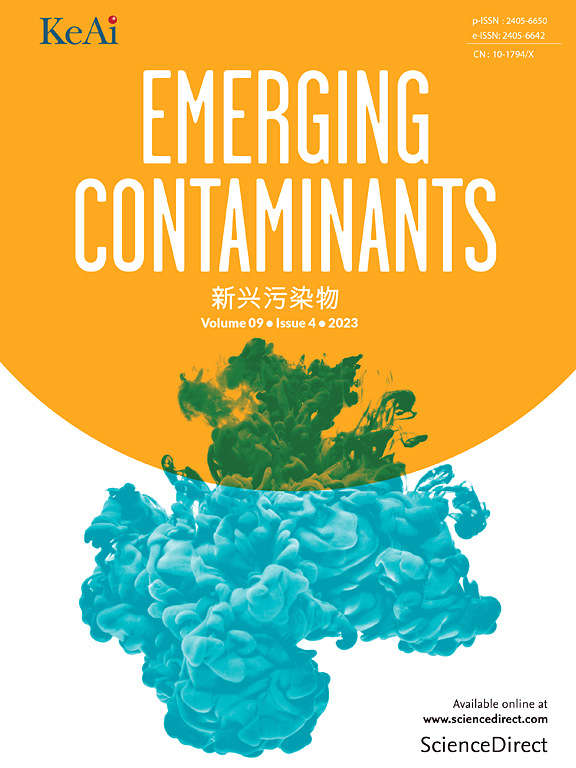一次性口罩释放的微塑料纤维对海洋硅藻毛藻的毒性以及EPS在对抗毒性作用中的作用
IF 6.9
2区 环境科学与生态学
Q1 ENVIRONMENTAL SCIENCES
引用次数: 0
摘要
由于新冠肺炎大流行,一次性口罩已成为海洋生态系统中微塑料污染的重要来源。硅藻作为初级生产者,经常被用作水生毒性评估的模式生物。只有有限数量的研究检查了面罩渗滤液(ML)对硅藻的毒性。然而,不同时间间隔释放ML的毒性机制尚不清楚。此外,细胞外聚合物质(EPS)在调节ML毒性中的作用也知之甚少。为了解决这些空白,我们从三个时间间隔(1天,14天和21天)研究了ML对海洋硅藻Chaetoceros sp.的毒性,发现毒性随时间而增加:14天ML >;为了评估毒性,我们估计了叶绿素色素水平、活性氧和丙二醛水平。此外,用电感耦合等离子体质谱分析了ML中重金属的存在。我们的研究结果表明,ROS的产生增加是毒性的关键机制,而EPS与原始ML相比减少了毒性作用。利用傅里叶变换红外光谱和3d激发发射矩阵光谱分析了EPS与ML的相互作用。使用Pearson相关性和热图来评估毒性终点之间的相关性。该研究为ML对海洋硅藻的环境影响提供了重要见解,并强调了EPS在减轻ML毒性中的作用。本文章由计算机程序翻译,如有差异,请以英文原文为准。
Toxicity due to release of microplastic fibres from disposable face masks on marine diatom Chaetoceros sp. and the role of EPS in combating the toxic effects
Due to the COVID-19 pandemic, disposable face masks have become a significant source of microplastic pollution in marine ecosystems. Diatoms, as primary producers are often used as model organism for aquatic toxicity assessments. Only a limited number of studies have examined the toxicity of mask leachate (ML) on diatoms. However, the toxicity mechanism of ML released at different time intervals is underexplored. Furthermore, the role of extracellular polymeric substances (EPS) in modulating ML toxicity is also poorly understood. To address these gaps, we investigated the toxicity of ML from three time intervals (1-day, 14-day, and 21-day) on the marine diatom Chaetoceros sp., finding that toxicity increased with time: 21-day ML > 14-day ML > 1-day ML. To assess the toxicity, we have estimated chlorophyll pigment levels, reactive oxygen species, and malondialdehyde levels. Furthermore, the presence of heavy metals in the ML was analyzed using Inductively Coupled Plasma Mass Spectrometry. Our results suggest that increased ROS production is a crucial mechanism of toxicity, while EPS reduces toxic effects compared to pristine ML. The interaction of EPS with ML was analyzed using Fourier-Transform Infrared Spectroscopy and 3D-Excitation Emission Matrix spectroscopy. Pearson correlation and heatmap were used to assess the correlations between toxicity endpoints. This study provides critical insights into the environmental impact of ML on marine diatoms and highlights the role of EPS in mitigating ML toxicity.
求助全文
通过发布文献求助,成功后即可免费获取论文全文。
去求助
来源期刊

Emerging Contaminants
Medicine-Public Health, Environmental and Occupational Health
CiteScore
10.00
自引率
6.70%
发文量
35
审稿时长
44 days
期刊介绍:
Emerging Contaminants is an outlet for world-leading research addressing problems associated with environmental contamination caused by emerging contaminants and their solutions. Emerging contaminants are defined as chemicals that are not currently (or have been only recently) regulated and about which there exist concerns regarding their impact on human or ecological health. Examples of emerging contaminants include disinfection by-products, pharmaceutical and personal care products, persistent organic chemicals, and mercury etc. as well as their degradation products. We encourage papers addressing science that facilitates greater understanding of the nature, extent, and impacts of the presence of emerging contaminants in the environment; technology that exploits original principles to reduce and control their environmental presence; as well as the development, implementation and efficacy of national and international policies to protect human health and the environment from emerging contaminants.
 求助内容:
求助内容: 应助结果提醒方式:
应助结果提醒方式:


